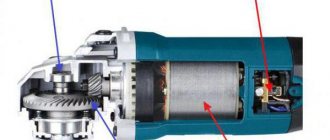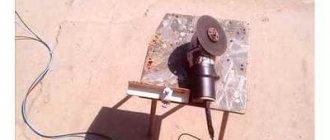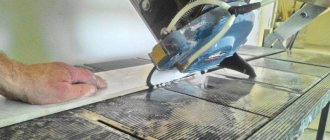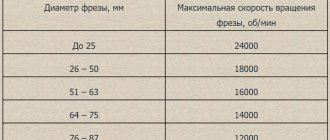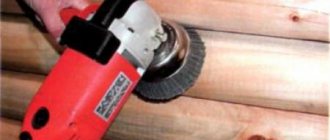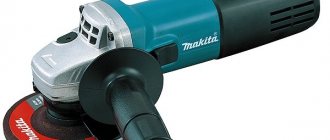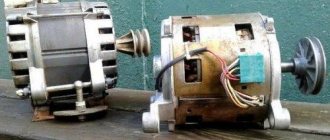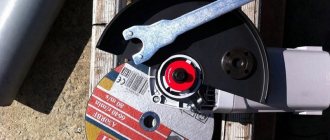Disk types
When using disks for a specific activity, it is necessary to select the desired disk, selected by function and type of building material. Circles vary in size (diameter 115 - 230 mm, thickness 4 - 20 mm) and building material. Markings corresponding to the building material are applied to diamond cutting discs:
- "Concrete" for reinforced concrete;
- "Granite";
- "Asphalt";
- "Building material" for brick or concrete.
Such discs are much thinner than grinding discs that have disc-shaped, cup-shaped or in the form of belts mounted on a disc-type rubber support disc. This type of disc produces both rough rough work and fine polishing to a mirror finish. The disk can be changed depending on the device model. For these purposes, you can use the key included with the device or a quick-release nut.
Grinder and grinder - how do they differ?
Grinder is the colloquial name for a power tool designed for abrasive processing of metal or other types of material.
How to choose an angle grinder or how to choose an angle grinder
The most important parameter when choosing an angle grinder is the size of the disc. The diameter of the disc determines the depth to which the device will cut the material. Also, do not forget that during operation the disc gradually wears out and becomes smaller, thereby reducing the cutting depth.
Choosing an angle grinder for the home. Main criteria
What characteristics of an angle grinder should you pay attention to before purchasing? Obviously, first of all, the choice will depend on the type of work expected. If it is not clear which angle grinder to choose for your home, that is, to choose a universal tool, then you should pay attention to the following characteristics:
- Diameter of the nozzle used. As noted above, a fairly simple selection criterion is used here - the more powerful the tool, the larger the nozzle. In turn, it is obvious that the larger the diameter, for example, of a circle for cutting metal, the thicker the workpiece you can cut.
- Rated power. Here the choice depends on the area of application of the tool. The range of this parameter is quite wide: from 0.6 to 2.7 kW. So, if you are buying a grinder for simple sanding of wooden surfaces, for example, then there is no point in buying a large powerful tool. Firstly, because it costs much more, and secondly, a heavy professional tool will not be able to reveal its capabilities. And in this case, it will be inconvenient to manipulate a large, heavy apparatus, which will only lead to rapid fatigue. Conversely, if you are going to cut concrete or metal workpieces, then you will need a powerful grinder with a large circle diameter.
- Rotational speed. The spindle speed range of an angle grinder varies from 2800 to 11000 rpm. More expensive models have the ability to regulate the speed, and if there is no such regulator on the instrument, then the principle works: the larger the disk, the lower the speed. The fact is that at a high speed of rotation of the nozzle, it is likely to be destroyed, which can lead to injury.
- Additional functions. Let’s look at this selection criterion in more detail in order to understand which grinder is better and make an informed choice.
Professional
How to choose an angle grinder for work on a construction site or for industrial production? The simplest answer is to choose a large angle grinder. The rated power of such a tool starts from 1.5 kW, which allows it to be used in intensive mode for a long time. Overheating of large and powerful angle grinders, unlike household tools, is practically excluded. In addition, professional angle grinders have higher wear resistance of parts, which significantly increases the service life of the power tool.
READ Grinder Bosch 125 with speed control
The body of the professional angle grinder is made of high-strength materials, which well protects the tool from various types of mechanical damage. Finally, the professional tool has more advanced features that make it easier to use. But professional-type angle grinders also have significant disadvantages. Firstly, it is heavy, which is due to both the large size and the presence of additional components. And secondly, the price of a professional tool can be several times higher than the price of an angle grinder for household use.
Grinders also differ in the presence of one or two handles. Everything is clear here. Large and heavy angle grinders with a power of more than 2 kW are equipped with two handles. For household mobile grinders, one handle is enough to hold them securely during operation.
Types of grinding machines
Belt sander. It is a tool where surface grinding occurs unidirectionally, using a sanding belt, which is placed on rollers provided for rotation. This type of tool is suitable for polishing large surfaces.
Vibratory sander . This type of machine is also called a surface grinder. It is an instrument with a flat sole, hence the name. Surface grinding occurs using reciprocating movements of the sandpaper. It is this action that is vibrational in nature. This type of machine also has vacuum cleaners for collecting construction dust.
For working on ledges and corners, there is another type of vibration-type machine, this is a delta sander . The sole of this type of tool has a triangular shape, which allows you to work in hard-to-reach places.
Eccentric sander. This type is commonly called orbital. The name again comes from the appearance of the grinding pad. It resembles an orbit or, more simply, a circle.
Angle grinder. This type of machine rotates around its own axis. In addition to grinding, the angle machine can cut metal, concrete and other materials.
Polishing grinder . The function of this tool is to polish metal and painted surfaces.
Brush sander . The brush performs the functions of a grinder, rotating along its axis.
Comparative analysis of electrical appliances
As can be seen from the above description of electrical appliances, the functions of these tools are 98% identical . Both devices are used for cutting, grinding and polishing metal, wood, plastic and other materials.
Grinding machines have a wider range of divisions of work areas (flat surface, corner). Also, many models have a vacuum cleaner function, which the grinder does not have.
Often, a grinder is used as a tool for cutting various materials, while a grinder is more intended for cleaning surfaces and subsequent polishing.
Choosing a Bulgarian woman does not at all mean finding a life partner from sunny Bulgaria or voting for a Bulgarian beauty at the next beauty contest, but this is exactly how a foreigner can understand the intention of a person from a post-Soviet country if this phrase is translated verbatim from Russian. After all, he doesn’t realize that in the countries of the former Soviet Union, choosing an angle grinder means choosing an angle grinder or an angle grinder, which is what it is, in essence.
The tool received such a strange nickname back in the distant 1970s, when Bulgarian-made manual angle grinders first appeared in the USSR, and since then the name “grinder” has been firmly stuck to this power tool. Even in stores today you can often find this word on the price tag, instead of the correct “angle grinder.” In this article we will try to understand the general outlines of what you need to know about an angle grinder or an angle grinder so that when you go to the store you can make an informed and correct choice.
Main manufacturers
The undisputed leaders among angle grinder manufacturers are Hitachi (Japan), Bosch (Germany), Makita (Japan), DeWalt (USA), DWT (Switzerland), Interskol (Russia), Sparky (Bulgaria). Russian models are not inferior in quality to foreign ones, but they are much cheaper.
Hitachi G12SR4 is an inexpensive, high-quality, medium-power model. An excellently balanced household model with minimal noise levels. The handle can be installed on both the left and right sides, which is also an advantage. However, it is not capable of working for a long time without interruption and in dusty conditions.
STANLEY STGS7115 is designed to work with small diameter discs. Comfortable to use, ergonomic and compact model. Its negative feature is the high noise level.
Metabo WEV 10-125 Quick has a speed regulator and is designed for discs up to 125 mm. A high-quality model equipped with electronic control of constant speed. Almost no shortcomings were identified.
AEG WS 13-125 XE is a powerful compact angle grinder for 125 mm discs. It has a lot of advantages, one of the best models for this circle diameter. Excessive rigidity of the power cable is practically the only drawback.
DeWALT DWE4215 is a powerful, balanced machine with a high level of dust protection. A comfortable and fairly light model that does not strain your hand during operation. Able to withstand fairly harsh working conditions. The lack of control and regulation of speed is a drawback that is not important enough for household models.
Concrete mixer: types, characteristics, differences, photos
Circular saw: types, characteristics, recommendations
Distinctive features of the grinder
The range of grinders is quite large and according to engine power they are divided into household and professional. The former have low power, simplified functions and shorter continuous operation time. An excellent option for home renovation and construction. The latter are distinguished by greater productivity and power. Professional angle grinders are equipped with adjustable spindle speed and can work for a long time without turning off. Household ones are equipped with a handle and have a power of 1.5 kW.
Manufacturers equip grinders with various useful functions:
- balancing, which stabilizes vibration, preventing the disc from beating on the surface being treated;
- control of disk speed;
- speed adjustment;
- soft start - it is convenient to work with such devices. They start at low speeds and gradually gain power;
- automatic shutdown of the brushes if a failure occurs in the electrical system.
The grinder is equipped with an angular gearbox, brushes (cutting, scraping, brush, disc, cup) or discs of different sizes. Suitable for working with an angle grinder are diamond cutting wheels, which can be used to work on granite, concrete and asphalt, as well as abrasive cutting wheels, which have proven themselves well when cutting ceramics, stone, metal, and slate.
Brush OSBORN P60
Household
Obviously, this group includes a tool that is not intended for intensive work in industrial production conditions. Household grinders have less power and size. The last criterion is especially important when you have to decide how to choose an angle grinder for your home, since the size of the attachment attachment directly determines what diameter of the circle is suitable for the selected tool. So, for home, not too frequent use, a grinder with a minimum circle diameter of 115 mm is quite suitable, but a professional will probably choose a large tool (up to 230 mm), not only because of its power, but also because those who came to change Nozzles with a larger diameter will fail much less often.
READ Why do the brushes on an angle grinder spark?
In addition, household angle grinders are not characterized by high productivity, since due to a lack of power and design simplicity, they quickly begin to overheat and when working with them, you have to take frequent pauses to cool them down.
Why you can’t polish with a grinder (my opinion) What is the difference between a grinder and a polisher
How to choose a grinding machine?
Before you start purchasing, you need to decide what specific device you need and what functions it should perform. The tape machine is designed to work instead of a plane. That is, the job of the tool is to roughly peel off the paint and level the surface. For vibration, work on wood, plastic and metal is more common. This machine produces high-quality cleaning and polishing of the material. The orbital sander is designed to work with convex and curved surfaces. Thus, before purchasing this kind of tool, it is important to decide what surface you will be working on and what requirements the electrical device must meet.
